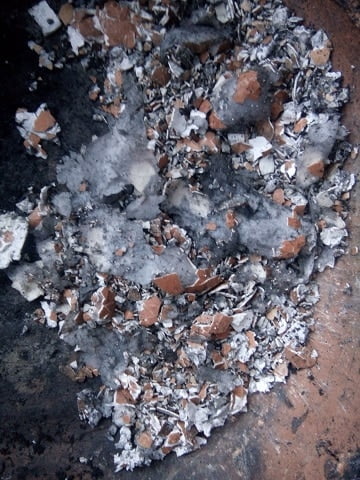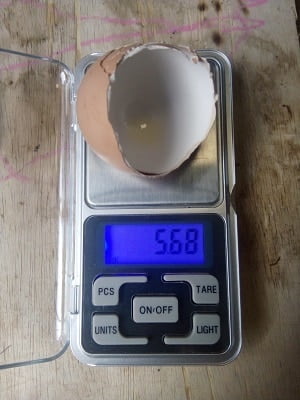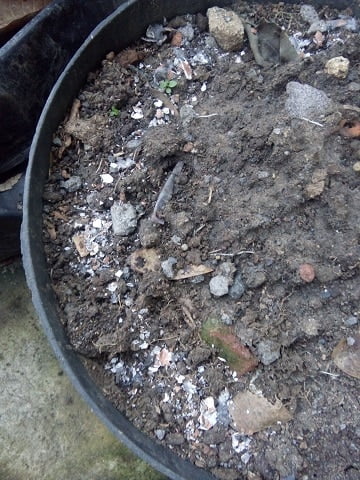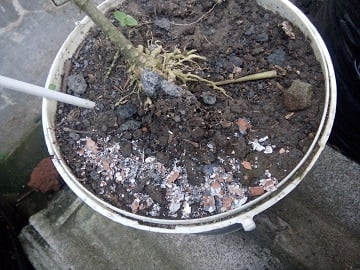How to use eggshells for plants? break the eggshell then spread it on the surface of the pot on the media. or, we can also mix eggshells with the planting medium.
Eggshells are very useful for plants. Because eggshells contain the dominant calcium. So, by getting additional calcium, plants can get a lot of good things.
Broadly speaking, the benefits of eggshells for plants are as follows:
- As an organic fertilizer.
- Alternative sources of calcium.
- Inhibits against certain pests.
Even though eggshells can be used more widely. Due to their high calcium content, eggshells have been widely studied for use in the culinary and health fields.
Eggshells can later be used as an ingredient in filling holes in teeth. Because of the minerals, especially high calcium.
It has been researched a lot, but whether it is a commercial product or not, it is still in search.
Likewise, its use in the culinary field. This will be a cheap alternative source of calcium.
Because the average food or beverage product with high calcium is more expensive. Especially with the target market for the elderly, the issue of bone loss (osteoporosis) can further increase the selling price.
But this time we will focus on using eggshells for plants only.
Plant need eggshells
Every plant needs calcium. In large and constant numbers in each stage of its growth. These include leafy greens, fruit vegetables, and large fruit plants.
Calcium is an important nutrient. Because it includes macronutrients that must be available to plants.
This element is one of the constituents of the cell wall in plants. Which can function to strengthen plant cell walls. Therefore, plants are more resistant to disease.
In addition, calcium also has a role in plant metabolism related to plant enzyme activity.
Benefits of calcium for plants
Calcium deficiency doesn’t just affect plant growth. However, it will also reduce the quality of the fruit produced.
Completely, plants that are deficient in calcium will experience this kind of problem.
- Leaves curled and wrinkled. Pale hard and curled.
- Leaf tops are scorched, sometimes young leaves have yellow spots or like there are burns on the tips of the leaves.
- Defective fruit.
- Stunted plant growth
- the leaves turn yellow, shrink, small, and fall easily, or in other words, the age of the leaves becomes short.
- flowers and fruit fall off easily
- plants susceptible to disease attack
- low-quality yields
- crops are easily damaged and rot
- Uptake of nutrients by plant roots is inhibited because root growth becomes stunted.
Plants in limited media have more potential for calcium deficiency
Plants grown in limited media have more potential for calcium deficiency. For example in pots, polybags, sacks, or other containers.
This is due to the habit of rarely adding agricultural lime (dolomite, Kaptan) to the growing media.
Yes or not?
What we find in the planting information in containers, rarely does suggest adding calcium fertilizer to the mixing medium.
In contrast to information on land processing in paddy fields and moor. Many recommend using agricultural lime.
Ignoring this source of calcium can have an impact on plant growth in our gardens. In fact, calcium is a macronutrient and is needed in a fairly large and constant amount.
In addition, recommendations for fertilizers that are used also rarely contain calcium. Usually, the fertilizer for the garden is only NPK. With various brands on the market.
NPK usually lacks calcium. The content is predominantly nitrogen, phosphorus (P), and potassium (K) or potassium.
This is one of the roles of eggshells that can be applied to plants in our gardens.
Calcium content in eggshells
In eggshells, there is very high calcium. From a reference, it is stated that in dry eggshells, the calcium content is up to 95 – 97%. [1]
But calcium is still in the form of calcium carbonate (CaCO3).
As for the elemental calcium alone, different sources state different amounts.
One states that the calcium in the eggshell is 9% [2] while the other is 40%. [3]
Another source, from IPB laboratory analysis, the calcium content of eggshells is as follows: [4]
| Water content | 1.74% |
| Ash | 96.48% |
| Calcium | 700.88 grams/kg |
| Fe | 0.07 grams/kg |
From the latest data, we can calculate the calcium level in eggshells is around 70%.
And it looks like it’s still in the form of calcium carbonate. Because if you look at how to make samples for lab tests, there is no calcination that can break down calcium from its calcium carbonate form.
Let me not be curious, this is how to prepare it.
The eggshells are washed and separated from the thin layer of a shell that is on the inside. Then wash the eggshell.
The shells were dried again with an oven at 80 0C for 10 minutes, followed by using them again at 60 0C for 3 hours.
After that, the shell is blended to make it flour.
It’s been like that. Low temperature and brief oven drying are only for drying eggshells.
This temperature has not been able to break down calcium from its carbonate compounds. So, most likely, the calcium that is produced is still in the form of calcium carbonate.
Then which one is correct for the calcium content in eggshells?
It could all be true. Because egg weight (including shell weight) can be affected by the ration eaten by chickens.
If the quality of the ration is different, (especially the number of minerals), then it is possible that the calcium contained in each egg from a different farm, the value could be different.
But the point remains the same, eggshells are a very high source of calcium fertilizer. And I need to say, this eggshell is quite light.
I tried to weigh it, and the result is like this.
The eggshell above is still wet. if dried first to dry, maybe the weight will be lighter.
This means that if you need a sufficient calcium source for plants, then you need many eggshells.
How to apply eggshells on plants
How to apply eggshells to plants is also very simple. We can easily crush, knead, mash or blend them.

Then we spread it around the plant or mixed it on the planting medium at the beginning of its preparation.
The amount doesn’t have to be too much. For polybags size, 30 cm, approximately 25 grams of eggshells are given.
This means only five eggshells. Because of each egg, the weight of the eggshell is only about 5 grams. If it’s dry, while if it’s still a bit wet, the weight is like the picture I weighed earlier.
The frequency of giving eggshells to plants is also not too frequent.
Please note, the addition of eggshells can increase the pH of the growing media we use.
If the pH gets too high, the result is not good for the plants. Because nutrients are not absorbed properly.
For the size of the media for planting polybags of 30 cm, the addition of eggshells once a month is enough.
Ideally every 2 months for long-lived plants. But for leafy vegetables that can be harvested for one month, the addition every month is sufficient.
Benefits of eggshells for plants
Let it not be like nonsense, we will see that the benefits of eggshells for this plant are really real.
From several references that I found, plants that were given additional eggshells grew better.
Eggshells can increase the pH of low growing media
Too much compost in the growing media can make the pH of the media acidic. The condition of the planting medium that is too low (acidic) is also not good for the nutrient absorption process.
By adding eggshells to the growing medium, the pH can be increased. But the increase in soil pH should not be too high. The ideal soil pH (planting medium) for plants is at number 6.
for that reason, adding eggshells to plants in pots or polybags should not be too much or too often.
25 grams of eggshell per plant can be done once every 2 months.
Based on research, adding eggshells to the growing media as much as 25 grams/polybag can increase the pH of the growing media from 4.2 to 4.8.[1]
Eggshell can make the plant taller.
One of the important benefits of eggshells for plants is that they can make plants taller. Of course, when compared to plants that are not given eggshells.
This indicates that calcium plays a very important role in the vegetative and generative growth of plants.
Do not be interpreted with calcium that comes from the eggshell is better. Not like that.
As long as the plants get enough calcium, they will grow equally well. Whatever the source.
Indeed, eggshells are included in organic calcium sources. For those who like farming or organic farming, eggshells can be a very economical choice.
This has also been proven by several scientific journals that I have collected. In brief, we can see the data in the table below.
| Effect of eggshell on plant height | |||
| Plant | Without Eggshell | Eggshell 25 gr/plant | Note |
| Adenium obesum | 6.03 cms | 10.79 cms | 2 months initial height 5 cm[1] |
| Spinach | 15 cms | 20 cms | hydroponic system[4] |
Apart from the two types of plants above, there is still additional data, namely celery and tomatoes. The result is more or less the same as the table above.
Namely, celery and tomato plants that were added with eggshells were higher.
Eggshell can increase the number of leaves
If the number of leaves, of course, this is because the higher the plant, the number of leaves must be more. Because of the height increases but the number of leaves is the same, it is called a finch, aka lack of sunlight.
That’s about the benefits of eggshells for plants.
In essence, this eggshell is an alternative source of calcium for plants. Then calcium will play its important role. As a result, plant productivity will be optimal.
Can eggshells increase plant fruit production?
The direct effect of calcium on fruit is not how much it produces. However, it is more to the quality of the fruit.
For example, in tomatoes, calcium can prevent tomatoes from experiencing bottom rot and fruit defects.
The elements that most influence the generative phase of plants are the P and K elements.
I think that’s enough for the benefits of eggshells on this plant. Sorry if there are many shortcomings, thank you, and see you again.
 JOYNIM FARM Goat Farming, Cattle Farm, Laying Hens, Quail Farm, Gardening
JOYNIM FARM Goat Farming, Cattle Farm, Laying Hens, Quail Farm, Gardening






